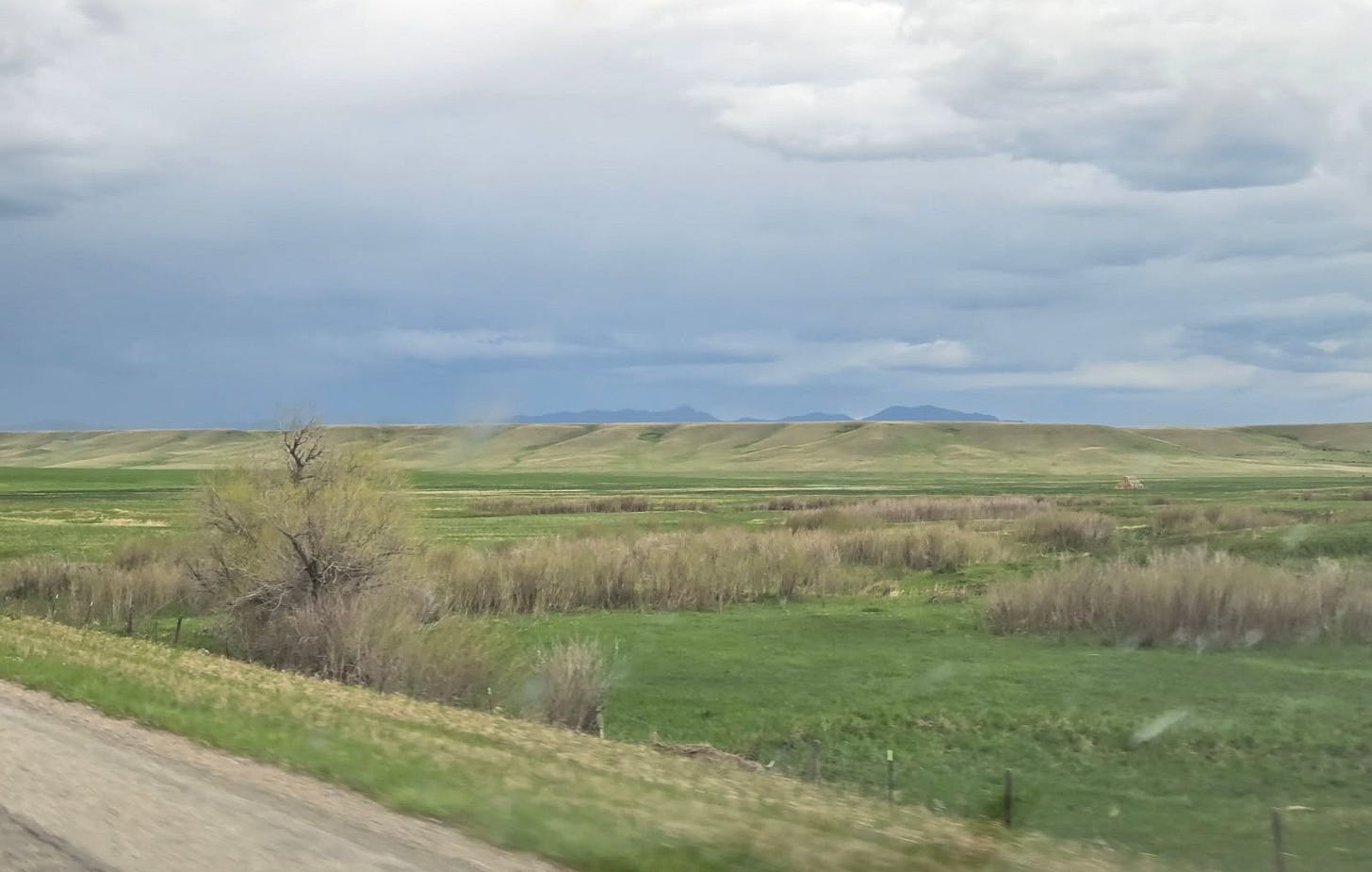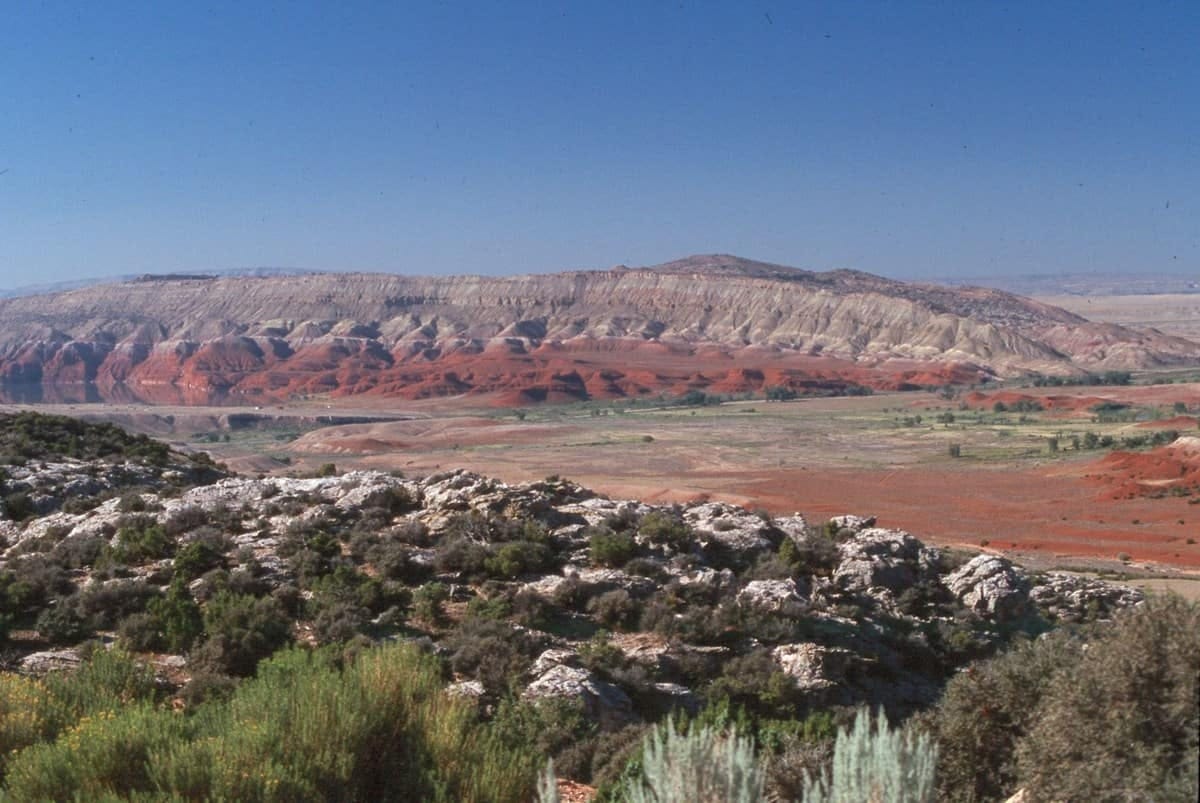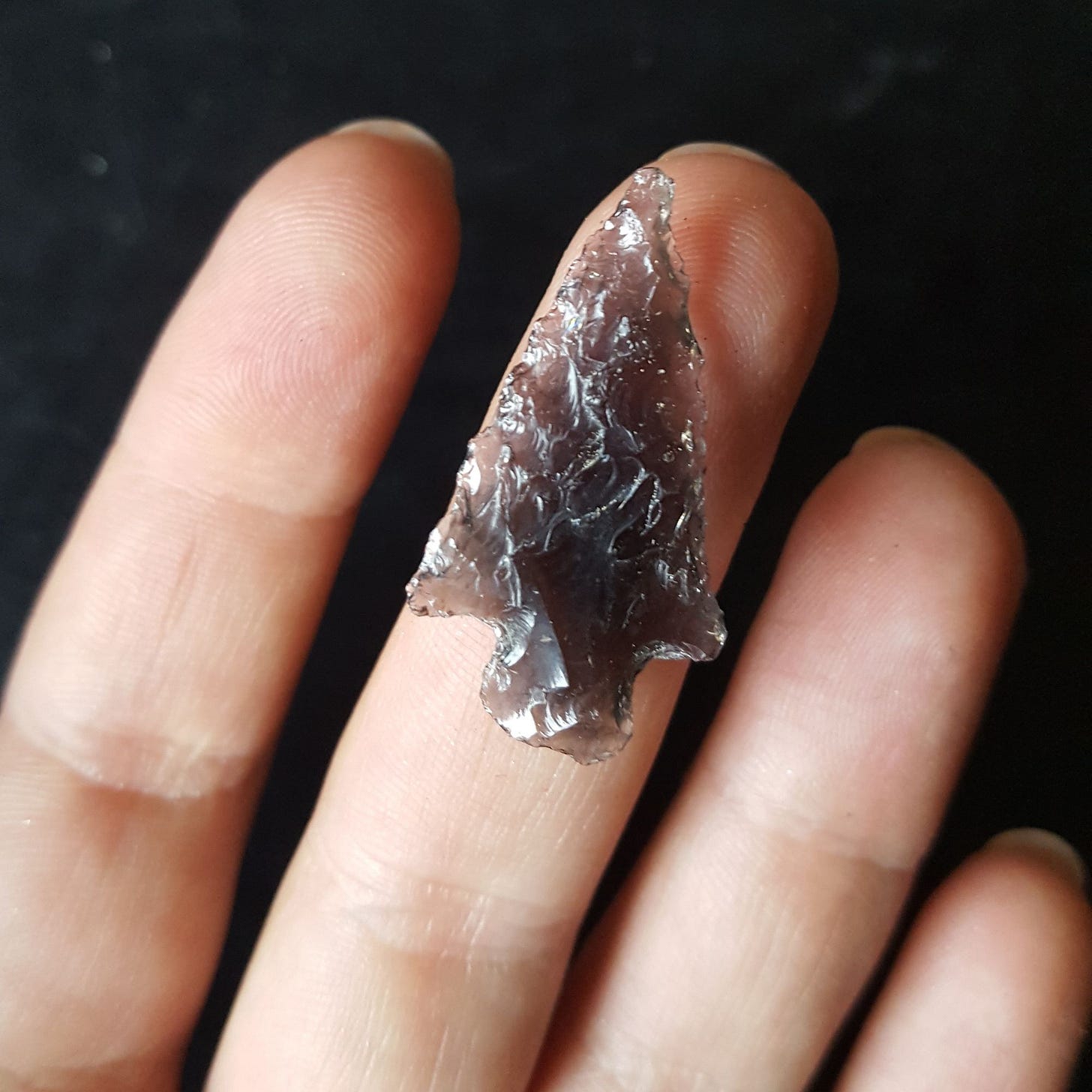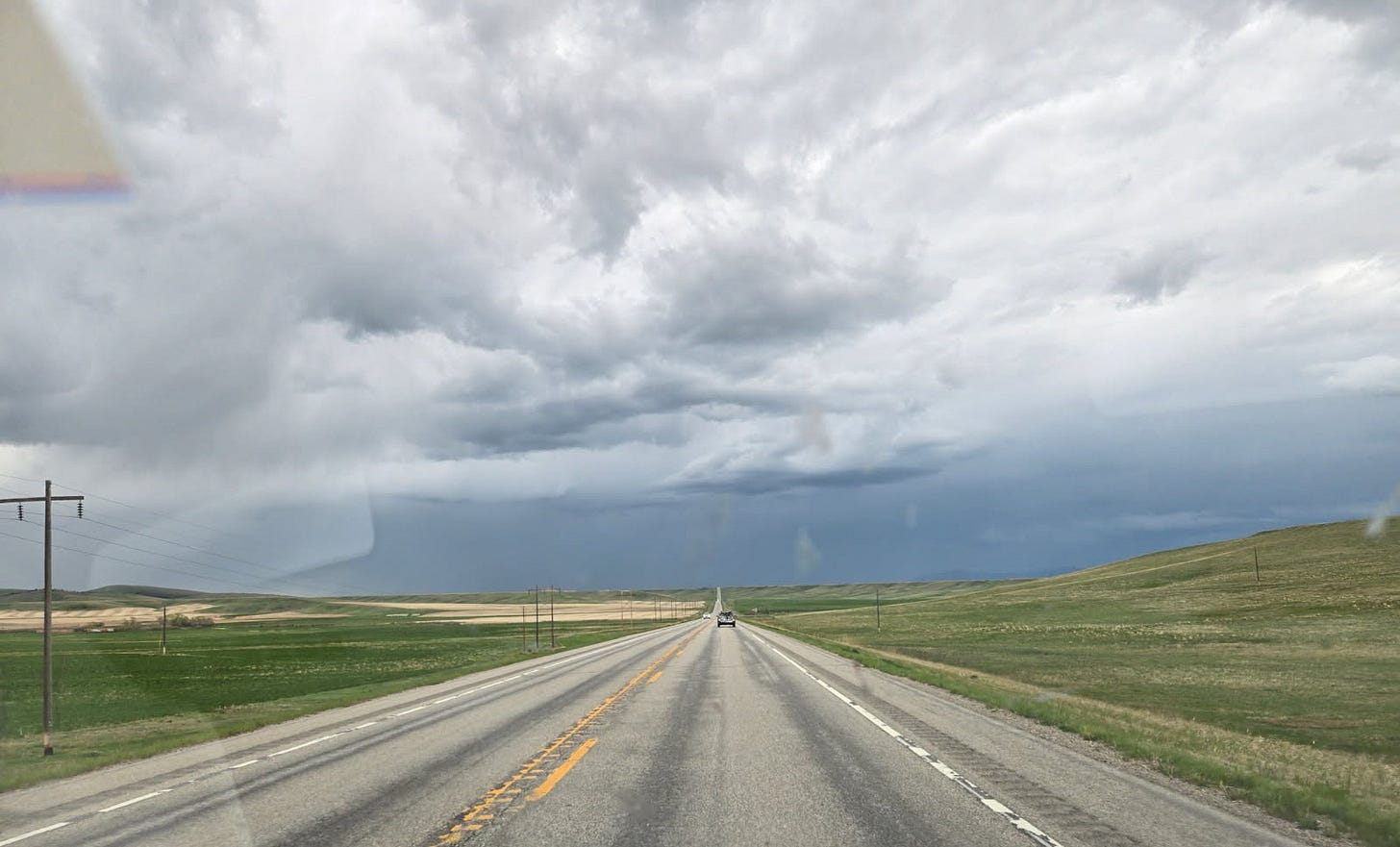Holding Hands with That Shift, or Shoving It from Behind
The proverbial needle is thousands of years old and exceedingly fragile.
This weekend, like most, I spent six hours driving between Lewistown and Great Falls, around 400 miles to pick up and drop off my kids from their dad’s house for their time with me. Most of the year when I make this drive, I’m racing to beat the sunset, wary of the especially twisted stretch of highway that runs through the Belts and causes my astigmatism to make tricks of the shadows. But it’s been different lately, a seemingly overnight shift into the goddamn gorgeous early summer of central Montana, all the signs of the season not just imminent but obvious. Snow drifts finally melt away to reveal how they’ve nourished the grass below, exploding the rolling hills into lush, iridescent green that makes the sky seem even more blue, even more enormous. Calves appear underneath their mamas like little miniature versions of their future selves. And of course the sun stays out, shepherding me home against a backdrop of beauty.
As I was driving this weekend, I threw on “the record” by boygenius. This album came out the year my partner and I started dating, when we lived in both of these cities and drove this highway every weekend to see each other. This season was tumultuous and transformative and memorable for many reasons. I listened to it every time I made the drive, watching the spring roll in as I was serenaded by Phoebe and Julien and Lucy, contemplating all the rapid change I was going through, all the enormous swirling feelings of loss and love and fear of the unknown that I didn’t know quite how to hold. And as I listened to these songs over and over, playing the album twice through on every drive, gripping ever more fiercely onto these words that spoke the truth of my many tangled emotions, the music mapped on top of the scenery mapped on top of the experience, and a multifaceted memory was carved into stone. “the record” will always be connected to that definitive era, but never in isolation. Rather, the multisensory, layered reminiscence will always be specific to the place and the season, that stretch of Highway 87 in the springtime and falling in love.
Recommended Reading
“Rattlesnake Woman” from hello, heart by Cathy Jo Beecher
From 2014 to 2016, Cathy Jo Beecher and I were in the same grad school cohort in the Anthropology Department at the University of Montana in Missoula, pursuing Master’s degrees in archaeology and biological anthropology, respectively. After graduation, our paths veered in different directions and we lost touch aside from silently following each other on social media — a tale as old as time. Yet, we’ve inexplicably come back into contact recently thanks to Substack, and have connected over the way we have both drifted into the creative world since our time at UM. I knew Cathy was a writer, but I was surprised and happy to hear that she wrote and is currently querying a memoir titled Field Notes For a Friend, bringing our timelines into eerily similar territory. She recently posted an excerpt from this memoir, an essay titled “Rattlesnake Woman.”
This piece takes place during an archaeological field season in the Great Basin region of Nevada in 2017, opening just as the crew is pulling up the site on which they will perform a pedestrian survey which will determine whether the land qualifies as eligible for protection under the National Historic Preservation Act. We aren’t given much of the legal or political background of why this crew is at this location specifically or what federal undertakings might potentially occur here, but that’s not what this piece is about. The effect is more beautifully ambiguous than that.
What strikes me the most about Cathy’s piece is her succinct and nuanced description of field work, her accurate inclusion of all the aspects of this harsh and often underappreciated work. It is a process that can be overwhelmingly vast, the effort of searching for a needle in a haystack when the proverbial needle is thousands of years old and exceedingly fragile, not to mention possibly sacred, depending on who it belongs to. She simultaneously laments and praises the meditative tedium of surveying, the hyperfocus simultaneously maintained by the these archaeologists working in silent parallel:
This survey protocol might qualify as a walking meditation: standing in nature, head bowed, scanning back and forth just a few feet before my shoes, making regular rhythmic steps, keeping pace, and mainly being silent. I felt my feet connect to every grain of shifting sand…The synchronicity of our muscles formed a covalent bond, like groups of soldiers’ bodies marching or dancers’ bodies twirling.
The piece also gives the reader a glimpse into the harsh weather conditions archeologists are often exposed to — here, the scorching deserts of Nevada — as well as the politics and culture of working on a survey crew. As the only woman on an all-male crew, we get a sense of the tough skin that she’s had to build up, the anticipation that she has learned to possess for teasing and gendered comparisons. Yet, despite the challenges of this type of work, it is clear that Cathy possesses a passion for it, drawn to its “rhythmic and meticulous physicality” as well as its unpredictability, how everything about working in the field is both the same thing day in and day out as well as a total surprise. She is comforted by drawing out the hidden knowledge of the past from below an otherwise unremarkable surface:
I think our excitement over a thousands-year-old piece of human-modified rock is less about the object and more about proof that other humans eked out a living in a harsh but beautiful landscape. Deep down, we archaeologists are nostalgic for a time we have never experienced.
There is a theme running through this piece of a paradoxical duality, of the juxtaposition of opposites, of two different things being true at the same time. In the first paragraph, we are met with the image of a Shoshone Tribal Elder next to a military escort at the entrance to the survey site, two individuals with markedly different connections to the land they are standing on. At the gate, the Elder offers a blessing song to the crew, and we are reminded that his tie to this place — “a connection to the land on a frequency we academics often struggle to hear” — runs far deeper than even the archaeologists can understand, let alone the US government. We see the sacred alongside the bureaucratic, the binary (does this site ‘qualify’ or not) alongside the spectral quality of nature, the beauty alongside the brutality of the great outdoors, the drive to discover and reveal and record alongside the instinct to keep these precious natural and cultural resources hidden for their own protection. I’d imagine there’s some level of mental gymnastics to balancing out these competing desires that lands somewhere around ‘do least harm’.
The final scene of this piece, as well as the title and incredible closing line, captures this juxtaposition of the earthly with the spiritual rather poignantly. When a Tribal Elder gives Cathy the name “‘To'-go-ah Hepi’—Rattlesnake Woman” and bestows upon her a protection against rattlesnake encounters for the rest of the field season, we get to witness the juncture where these two worlds meet. And not just meet, but come together in harmony. It is in this interaction that we can start to understand the comfort that Cathy finds in this work and recognize the power of the land and the past on many different levels.
Prompt
This week is a picture prompt. Let this image spark whatever it sparks and run with it. Who are these characters? How do they know each other? Why are they here?
Writing Update
I’ve taken a little bit of a break from the page this week to recoup from the submission scramble so I don’t have anything new to share. But my drive described above reminds me of this piece that I wrote around a year ago. It’s definitely in draft-mode, doesn’t really go anywhere or have a point, but I think it captures the atmosphere of this environment well:
No one has driven the stretch between Lewistown and Great Falls, Montana more times than I have. It’s not impossible to estimate the number, but I’d rather it remain infinite and immeasurable.
I’ve built a routine into the trip, knowing exactly where to stop for the cheapest gas, the best selection of snacks, the least disgusting bathrooms or pit stops where I can hide thoroughly enough to piss on the side of the road. The miles taste like the sour chemical bite of energy drinks and gas station coffee. What I’ve shaved down to a ninety-minute drive now seems like a blink. Sometimes I’ll unconsciously black it out the way you do with a task that is habitual and unquestioned, like brushing your teeth or making love.
I’ve become infinitely familiar with the route, having driven it so many times, ingrained in my body with a cadence that is nearly biological. I subconsciously anticipate each curve and straightaway, the topography of the rising hills and falling valleys as familiar as the dips and curves of my own body. I can replicate down to the minute the exact time it takes to drive between each speed trap town, strung along US Highway 87 like beads on a necklace. I know just when one lane will fortuitously open into two and in which blind spots highway patrolmen like to hang out, waiting for people like me — zoned out with the cruise set on a cool and controllable eighty — to blast by.
I’ve come to not only enjoy these drives, but respect them, revere them. The beauty of the central Montana landscape is undeniable. It’s unlike the jagged mountains of northwest Montana where I went to college, or the craggy bluffs and scratchy sagebrush of eastern Montana where I grew up. Here, plains stretch endlessly toward the relief of the horizon, reaching for the suggestion of mountains hundreds of miles into the distance. Hills roll carelessly, dotted with hay bales or snowdrifts (depending on the season) that cast shadows over the smooth oceans of grass. The clouds are gigantic, colossal tufts of white if they aren’t the technicolor dreamscape of a sunset or sunrise, blasting apart the sky in unimaginable hues of pink and orange and violet. It’s a postcard. It’s a calendar. It’s why Montana is “the last best place”, “Big Sky country”. It’s nothing short of idyllic. It’s incredible that this state, so giant and vast and reaching, can hold so much.
I’ve witnessed my fair share of roadkill along this road, and thankfully (knock on wood) never hit any myself. Ungulates of all types are par for the course. Deer, hundreds and hundreds of them. Antelope, recognizable by their lithe and lively bounce. Cattle, obviously, fat for slaughter or milk or calf, even the wobbly knobby-kneed babies themselves, a perennial sign that spring is nye. A few bison once. Pheasants dragging their plooms along the highway like a poor man’s version of a peacock. Skunk announcing themselves with that pungent, marijuana-esque aroma miles before you’ll see the black and white pile of their body. I once got stuck behind a tractor in a particularly narrow and windy stretch and followed him at a frustrated thirty miles per hour for dozens of miles before I was able to pass him. As I pulled around him, I noticed something dangling from the raised bucket, dark legs swaying with every revolution of its enormous tires. By the time I’d pulled in front of him and took in the ghastly sight in my rearview mirror, I realized it was the corpse of a steer, hulking and shiny black and dead. Even as the highway stretched between us, I could make out its pink bloated tongue falling out of its dead lolling head. I tempted danger to pull out my phone, open my notes app, and type, “cattle corpse: best ever name for a metal band?”.
The drive, with its solitude and sensory settling, easily lend itself to allowing writing ideas to bloom, inspired both by minute details I witness along the way or by the miraculous crystallization of my imagination in the absence of distraction. Like with the cattle corpse, I’ve filled my notes app with more of these fleeting ideas than I can count, often typed blindly in some abbreviated version with which I try to capture the essence of the idea without risking my life too intensely. Sometimes I go back to these musings later and have forgotten entirely what I meant by my brief shorthand or its too misspelled and incorrectly autocorrected to translate its original meanings, but often I can’t wait to transcribe these thoughts onto paper and watch them blossom into a fully embodied story or weave themselves into the lines of a poem.
Moccasin is a tiny unincorporated town along the soft curve of the highway between Hobson and Stanford. There is no school, no gas station. The speed limit doesn’t even drop as you pass through. You could quite literally blink and miss it. But every single time I’ve driven by I’ve noticed the car. It’s a tan and wood paneled station wagon perpetually parked in front of a mint green, seemingly abandoned building on the edge of town abutting the highway. Its tires are blown and crackling with age so it rests precariously on its wheels and a few scraps of brittle rubber. It’s parked halfway in what would seemingly be the street, but clearly not enough traffic clears this street to necessitate its removal — anyone who needs to must just drive around it. The building it sits in front of doesn’t look much better off. Its windows are boarded up, its porch is rotting, its shingles are melting onto the grass below. It's obviously uninhibited but seems like the perfect match for the station wagon. I can’t say why this tableau intrigues me so much. The randomness, the specificity, so distinct it's unreplicable. I tell myself every time that I’m going to stop and take a picture. I never have.
There’s a story here, I tell myself every time I drive by, taking in this tableau, in all its stillness, its stagnation, decay and abandonment, active and in progress. There’s a reason why these things laid to rest where they did, the way they did, maybe forever. They may be still and lifeless now, but they were once if not alive, active, moving, useful. Just like this town, or what used to be one, was once maybe not bustling, but at least functioned. There was a distinct moment, as there always is within any monumental shift, where there occured a change of state, a specific changeover from one thing to another — from occupied to abandoned, from town to unincorporated community, from snowflakes into rain. And holding hands with that shift, or perhaps shoving it from behind, is a reason, a catalyst of some kind. At one time, the wheels of that station wagon turned for the last time, and there was a reason why. Maybe someday I’ll find out, or maybe I’ll just make it up, write the story myself.
Thanks as always for reading. Hope this endless month is treating you well and ushering you gently into summer.
xoxo,
brit









